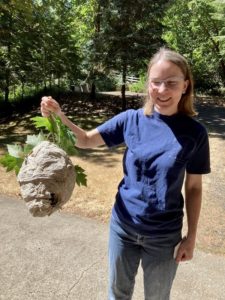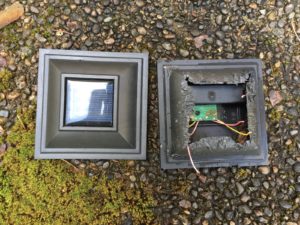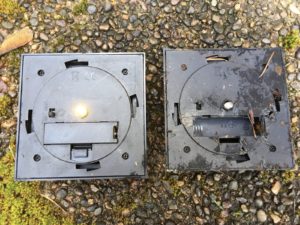May 25th, 2024 at 11:44 am (Animals, Language)
I just learned that the chickadee’s call is modified to convey key information – in ways that humans can understand, too! It turns out “chick-a-dee” is their alarm call, and the number of “dee”s tacked on to the end of the call conveys the magnitude of danger. I’ll definitely have to listen for this the next time I get to hear them!
Comments
August 10th, 2023 at 6:04 pm (Animals)
The other day, I discovered an enormous wasp nest (about 14″ in diameter) in a tree next to my house:
The next morning, Google helped me discover Dan Scollard, who comes out to remove wasps from homes, humanely “sends them to sleep” in a cooler full of dry ice, then donates them to a lab that extracts the venom for use in allergy shots. (!)
When he arrived, he said, “Oh, that’s a beauty. A lot of people say they found a nest as big as a basketball, but yours actually IS.”
My nest was constructed and occupied by the bald-faced hornet (which apparently is actually a wasp). Dan told me all about this wasp; he has a real admiration for them. I highly recommend reading about their life cycle and also viewing Dan’s photo gallery! These wasps are a useful part of nature, but risky to have next to your door where you (or unwitting visitors) could be suddenly attacked. Apparently this wasp can be quite aggressive and territorial.
Dan put on all of his gear, then vacuumed up all of the wasps around the nest, waited a bit for more wasps to come home from hunting, did a second vacuuming pass, and clipped the nest from the branch to remove it. He said it would hang it in his backyard so the queen (who had not emerged) could “live out the rest of her days in peace.” He said I could hold the nest with its lurking queen: gosh wow!

What an amazing experience! It’s a joy to meet knowledgeable people who love their subject and use their knowledge to do good in the world. I’m much happier sending these wasps out to help people avoid severe reactions, and the process was so much better than dousing the nest with poison. Thank you, Dan!
1 Comments
1 of 1 people learned something from this entry.
August 5th, 2022 at 9:16 pm (Animals)
While cleaning my windows today, I removed the screens and made an unpleasant discovery. Some insect had wedged bits of material into little nests around the edges of two window screens. I brushed it off, noticing that each nest looked like brown dried grass with a bright green squishy center. Then I looked more closely at what plopped onto the ground. The bright green bits looked like baby grasshoppers. Were they grasshopper nests? (In the windows?!)
Then a wasp flew up… carrying one of the bright green grasshopper like things, which was a bit larger than it was! It flew to where the screen had been and kept bumping along the window frame looking for the nesting site (presumably). Was it food? What? This is exactly what it looked like:

Some googling brought me to this description of the grass-carrying wasp, an insect I’d never heard of. Apparently they bite off bits of grass to wedge them in “cavities.” They then hunt for tree crickets. When they find a cricket, they sting it, paralyze it, and carry it off to sequester in a grass-lined nest, then lay an egg on it. When the egg hatches, the larva can immediately start eating the cricket. I was nauseated by the description, yet simultaneously felt bad at having cleaned out all the nests, after reading the very sympathetic description of this “beneficial wasp” at the above link. (Apparently ridding the trees of crickets that feast on them is good, and the wasps are also pollinators and not aggressive.)
Still, I don’t really want them in my windows! And I think my forest offers many other hollow woody crevices for the wasps to populate. To me the most salient part of their behavior is the cricket-hunting, paralysis, and egg-laying, but I guess the grass nesting is kind of interesting too (it’s not just for the birds!). I hope they enjoy feasting on the local tree crickets!
Comments
April 11th, 2021 at 10:27 pm (Animals, Vocabulary)
So… there’s a faint northern constellation called Camelopardalis. It is so named because someone thought it looked kind of like a giraffe. Which was known as a kamelopardalis, or a camel-leopard, in Greek – because come on guys, it has a long camel-like neck and it also has spots! This cracks me up! :) Words are awesome!
Surprisingly, even English-speaking folks used “camelopard” in medieval times (pr. kuh-MEH-luh-pard).
Of course then I had to wonder why we started calling it “giraffe”. Apparently “giraffe” derives from the Arabic word “zar?fah” (fast-walker). So that one’s pretty good, but not nearly as descriptive. I say, bring back the camelopard! Who’s with me?
Comments
March 28th, 2021 at 2:11 pm (Animals, Technology)
 Last year, I bought some solar-powered garden lights and put them along my driveway to make it easier (and more welcoming) to follow the driveway to my house. I was very pleased with the little spots of light marking the edge of the driveway. Then I kept finding two of them knocked over… with scrape/gnawing marks on them. The top part of one disappeared entirely. These had plastic tops, and maybe weren’t as durable, but it was weird to have a piece just disappear. What animal would want it? But what human would take just the top of one light? The two affected lights were under a tree, and squirrels maybe jumped onto them? My best hypothesis was that the squirrels thought they were some kind of bird feeder and hoped there were seeds inside the glass. I finally relocated them to the front of the house and bought metal ones to replace along the driveway. Neither set has suffered further attacks.
Last year, I bought some solar-powered garden lights and put them along my driveway to make it easier (and more welcoming) to follow the driveway to my house. I was very pleased with the little spots of light marking the edge of the driveway. Then I kept finding two of them knocked over… with scrape/gnawing marks on them. The top part of one disappeared entirely. These had plastic tops, and maybe weren’t as durable, but it was weird to have a piece just disappear. What animal would want it? But what human would take just the top of one light? The two affected lights were under a tree, and squirrels maybe jumped onto them? My best hypothesis was that the squirrels thought they were some kind of bird feeder and hoped there were seeds inside the glass. I finally relocated them to the front of the house and bought metal ones to replace along the driveway. Neither set has suffered further attacks.
Recently I was doing some yard work, and I found the missing top, buried in leaves! But it just raised more questions. Because something spent some serious time and effort extracting just the solar panel. See below an undamaged top (left) and the one I found (right):

You can click to enlarge. It looks like dedicated… gnawing, to me. A human would have used a tool – or just taken the whole top with them (why dig out the solar panel and then leave the shell?).
The back side is equally weird, with the rechargeable battery and its cover removed. A human would have opened the cover with their fingers. Instead, whatever took this battery dug/gnawed it out.
This no longer looks like someone thought it was a bird feeder.

So I’m standing here with this chewed-up solar light and I’m wondering just what kind of squirrel is hungry for this technology. Or am I living next to the rats of NIMH? Help?
4 Comments
1 of 2 people learned something from this entry.


 Last year, I bought some solar-powered garden lights and put them along my driveway to make it easier (and more welcoming) to follow the driveway to my house. I was very pleased with the little spots of light marking the edge of the driveway. Then I kept finding two of them knocked over… with scrape/gnawing marks on them. The top part of one disappeared entirely. These had plastic tops, and maybe weren’t as durable, but it was weird to have a piece just disappear. What animal would want it? But what human would take just the top of one light? The two affected lights were under a tree, and squirrels maybe jumped onto them? My best hypothesis was that the squirrels thought they were some kind of bird feeder and hoped there were seeds inside the glass. I finally relocated them to the front of the house and bought metal ones to replace along the driveway. Neither set has suffered further attacks.
Last year, I bought some solar-powered garden lights and put them along my driveway to make it easier (and more welcoming) to follow the driveway to my house. I was very pleased with the little spots of light marking the edge of the driveway. Then I kept finding two of them knocked over… with scrape/gnawing marks on them. The top part of one disappeared entirely. These had plastic tops, and maybe weren’t as durable, but it was weird to have a piece just disappear. What animal would want it? But what human would take just the top of one light? The two affected lights were under a tree, and squirrels maybe jumped onto them? My best hypothesis was that the squirrels thought they were some kind of bird feeder and hoped there were seeds inside the glass. I finally relocated them to the front of the house and bought metal ones to replace along the driveway. Neither set has suffered further attacks.
